#Modbus to IoT gateway
Explore tagged Tumblr posts
Text

Discover the top 5 reasons why RS-485 IoT Gateways are essential for efficient and reliable industrial automation systems. Boost performance today!
#RS 485 IoT Gateway Solutions#Industrial IoT Gateway Solutions#industrial iot gateway devices#IOT gateway devices#IIoT gateway devices#MQTT IoT gateway#iot gateway manufacturers#Top IoT gateway companies#IoT gateway company#iot gateway solutions#modbus gateway#rs485 gateway#rs485 protocol#modbus rs485#modbus communication protocol#rs485 iot gateway#modbus protocol#iot gateway
0 notes
Text
Take BL101 as an example to illustrate what is Modbus gateway
An Industrial IoT Modbus gateway is a device that connects Modbus-based devices in an industrial environment to an IoT (Internet of Things) network. BL101 is a typical Modbus gateway from BLIIoT. Here's a breakdown of the key components and functionalities:
Modbus Protocol: Modbus is a commonly used communication protocol in industrial settings that allows devices, such as sensors, actuators, and controllers, to communicate and exchange data.
Gateway Functionality: The gateway acts as an intermediary between the Modbus devices and the larger IoT network. It allows Modbus devices to communicate with IoT platforms, cloud services, or other connected systems. As BL101, it can connect to devices via Modbus protocol and upload data to the could platform.

Data Conversion: The gateway typically performs data conversion tasks, as Modbus data formats may differ from those used in IoT platforms. It translates Modbus data into a compatible format, such as JSON or MQTT, allowing seamless integration with IoT systems. BL101 supports Modbus RTU, Modbus TCP, DL/T645 to MQTT, OPC UA, Modbus TCP protocol conversion.

Connectivity: Industrial IoT Modbus gateways offer various connectivity options, including wired connections like Ethernet or RS-485, or wireless options like Wi-Fi, Bluetooth, or cellular networks. This flexibility enables connecting to Modbus devices in diverse industrial environments. BL101 provides 1 RS-485/RS-232, 2 RJ-45 and 4G network, and acquires 4000 data points from 100 devices by Ethernet and Serial Ports.
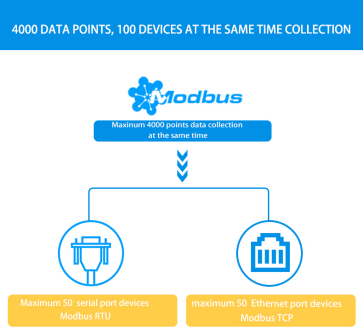
Security and Protocol Support: As industrial environments require stringent security measures, these gateways often incorporate advanced security features such as encryption, authentication, and firewall capabilities. About BL101, it supports data TSL/SSL, X.509 certificate, key encryption, OpenVPN, APN private network, offline caching and other security gateway features. Also, it supports Software/Hardware watchdog with high reliability. Additionally, they support various Modbus protocols, such as Modbus TCP/IP or Modbus RTU, to accommodate different devices.
Data Management and Analysis: Once the Modbus devices are connected to the IoT network through the gateway, the data can be uploaded to the could platform and managed, analyzed, and acted upon. However, BL101 supports Huawei IoT, Alibaba IoT, ThingsBoard, Ignition SCADA, SparkplugB, DCS, MES, BLIIoT cloud, etc. This enables industrial businesses to carry out real-time monitoring, predictive maintenance, data analytics, and other IoT-related applications.
By utilizing an Industrial IoT Modbus gateway, businesses can leverage their existing Modbus infrastructure while integrating it with modern IoT networks, allowing for more efficient industrial automation, monitoring, and control.
0 notes
Text
Latest Trends in Modbus Gateway Technology in India
India's industrial automation sector is evolving rapidly, and Modbus Gateway technology is advancing to meet growing demands. One significant trend is the integration of IoT with Modbus Gateways, enabling real-time monitoring and remote control. Gateways now support cloud-based systems and wireless connectivity, making industrial systems smarter and more adaptive.
#Modbus Gateway suppliers#Temperature data logger manufacturers in India#Hart to Modbus Gateway suppliers.
0 notes
Text
IoT Gateway: The Key to Efficient Water Monitoring Systems

In today’s world, where clean water is a pressing concern, monitoring water quality has become more important than ever. Whether it's for drinking, agriculture, or industrial use, ensuring safe water is essential. This is where the Internet of Things (IoT) plays a big role. Specifically, the IoT gateway acts as the backbone of any smart water quality monitoring system. But what makes it so important?
In this blog, we will explore the key role an IoT gateway plays in water quality monitoring. We will also understand how it connects different devices, handles data, and ensures efficient communication between sensors and cloud platforms.
What Is an IoT Gateway?
An IoT gateway is a device that connects IoT sensors and devices to the cloud or a central server. It collects data from different sensors, filters it, and sends it to a platform for analysis. Think of it as a bridge that enables communication between the devices on the ground and the software that processes data.
For water quality monitoring, this means receiving signals from sensors that detect pH levels, temperature, turbidity, dissolved oxygen, and other parameters. Without an IoT gateway, it would be difficult to gather all this information in real-time.
Why Is IoT Gateway Crucial for Water Quality Monitoring?
1. Real-Time Data Collection and Transmission
Water quality can change quickly due to weather conditions, pollution, or human activity. An IoT gateway helps in collecting data from various sensors in real-time. This allows authorities or businesses to act quickly if there's any issue with water safety.
2. Device Compatibility and Integration
Different sensors from different manufacturers can be used in one system. An IoT gateway ensures all these devices work together smoothly. It supports multiple protocols like MQTT, Modbus, and HTTP, making integration easier.
3. Data Preprocessing
Raw data from sensors might not always be usable directly. The IoT gateway filters and processes this data before sending it to the cloud. This reduces the load on cloud servers and improves response time.
4. Reliable Connectivity
Many water sources are located in remote or rural areas where network coverage is weak. A good IoT gateway can store data locally during connectivity loss and forward it once the network is restored.
5. Enhanced Security
Water quality monitoring involves critical data. IoT gateways come with built-in encryption and firewall settings to protect data from unauthorized access or cyber threats.
Application of IoT Gateway in Real-World Water Systems
IoT gateways are now widely used in various water-related projects. For example:
Urban Water Supply: Ensures the water reaching households is safe to use.
Agriculture: Monitors water quality in irrigation systems to avoid crop damage.
Industrial Use: Keeps a check on water discharged from factories to avoid environmental pollution.
IoT Tank Level Monitoring: IoT gateways help in reading the water level and quality data from tanks and storing it securely.
Integration with Industrial IoT Systems
In many industries, water is used in production processes, cooling, and cleaning. Monitoring water quality here is crucial. The industrial IoT setup often includes several machines and sensors working together. The IoT gateway collects data from all these points and ensures that everything is operating within safe limits.
This not only improves operational efficiency but also helps in meeting regulatory standards and avoiding fines.
Role in IoT Device Monitoring
The IoT gateway doesn’t just connect sensors. It also plays a major part in IoT device monitoring. It keeps track of the status of each device, ensures they are working properly, and sends alerts if any device stops functioning. This makes system maintenance easier and prevents long downtimes.
For example, if a pH sensor stops sending data, the gateway can trigger an alert immediately, so it can be fixed before the problem spreads.
Remote Monitoring and Management
One of the biggest advantages of using an IoT remote monitoring solution is that it allows you to manage water systems from anywhere. The IoT gateway makes this possible by continuously sending data to the cloud. Users can then log in through a dashboard or app and view real-time water quality reports.
This is especially useful in large areas like cities or agricultural fields, where visiting each site manually would take too much time.
Efficient IoT Device Management
With so many sensors and devices involved, managing them can be a big task. This is where IoT device management becomes important. Through the gateway, users can update firmware, restart devices, or reconfigure settings remotely. This saves time and reduces the cost of manual maintenance.
It also allows businesses to scale their operations. For example, if a water treatment company wants to expand to new locations, they can simply add more sensors and configure them through the same system.
Challenges and Considerations
While the benefits are clear, there are some challenges in using IoT gateways for water quality monitoring:
Initial Cost: High-quality gateways can be expensive, especially for small businesses.
Power Supply: In remote areas, ensuring a continuous power supply can be tricky.
Data Overload: Without proper filtering, too much data can slow down the system.
Technical Knowledge: Setting up and maintaining an IoT system needs skilled professionals.
However, with proper planning and support, these challenges can be managed.
Future of Water Quality Monitoring with IoT Gateways
As more people become aware of the importance of clean water, the demand for smart monitoring systems will grow. IoT gateways will play a bigger role in automating tasks, improving response times, and providing accurate data for better decisions.
We can expect to see:
More solar-powered gateways for remote areas
AI-based data analysis linked through the gateway
Better integration with mobile apps for user-friendly access
Final Thoughts
Water is one of our most valuable resources, and protecting it should be a priority. Using an IoT gateway in water quality monitoring ensures that we get accurate, real-time data to make better decisions. Whether it’s for cities, farms, or industries, IoT gateways provide the foundation for smarter, safer water systems.
They also support a range of technologies such as IoT tank level monitoring, industrial IoT, IoT device monitoring, IoT remote monitoring solutions, and IoT device management, making them an all-in-one solution for modern water systems.
By adopting IoT gateway technology, we take one big step towards sustainable water management and a healthier future.
0 notes
Text
IoT Gateway Devices: Powering Intelligent Connectivity with Creative Micro Systems
As the Internet of Things (IoT) continues to revolutionize industries from manufacturing to healthcare, one critical component is making this interconnected world possible—IoT gateway devices. At Creative Micro Systems, we specialize in designing and manufacturing high-performance IoT gateway devices that enable secure, seamless, and intelligent data flow in connected environments.

What Are IoT Gateway Devices?
IoT gateway devices serve as communication hubs in an IoT architecture. They collect data from various IoT sensors and devices, perform local processing or filtering, and transmit the data to cloud-based platforms or enterprise servers for further analysis. These devices bridge the gap between the physical world and digital infrastructure, ensuring that only relevant, actionable data is transmitted—improving efficiency and reducing bandwidth consumption.
In addition to data transmission, gateways are responsible for translating different communication protocols (like Zigbee, LoRa, Bluetooth, and Modbus) into formats compatible with cloud systems. They also add a crucial layer of security, performing encryption, authentication, and even real-time anomaly detection.
At Creative Micro Systems, we understand that no two IoT applications are the same. That’s why we offer custom-built IoT gateway devices tailored to meet the specific needs of each client. Whether you’re managing a smart agriculture project or overseeing a smart factory floor, our gateway solutions are designed for reliability, scalability, and security.
Our IoT gateways come equipped with:
Multi-protocol support for seamless device interoperability
Low power consumption, ideal for remote or resource-constrained environments
Advanced cybersecurity features, including encrypted communication and secure boot
OTA (Over-the-Air) updates to keep firmware current without manual intervention
Industry Applications
Creative Micro Systems' IoT gateway devices are deployed across a range of industries:
Industrial Automation: Monitor machinery performance and detect anomalies before failures occur
Healthcare: Enable secure patient monitoring and data sharing between medical devices
Smart Cities: Manage energy usage, traffic systems, and public infrastructure from a unified platform
Each gateway is engineered to operate in harsh conditions, with rugged enclosures and reliable wireless and wired connectivity options, making them suitable for both indoor and outdoor deployments.
Why Choose Creative Micro Systems?
Our strength lies not only in our cutting-edge technology but also in our collaborative approach. From initial consultation to final deployment, Creative Micro Systems works closely with clients to ensure each solution is aligned with their operational goals. Our in-house R&D, firmware development, and quality assurance teams guarantee a seamless experience from concept to execution.
IoT gateway devices are more than just data conduits—they're the brain of your IoT network. With Creative Micro Systems, you're choosing a partner committed to innovation, customization, and long-term value. Explore the future of connected intelligence with us.
0 notes
Text
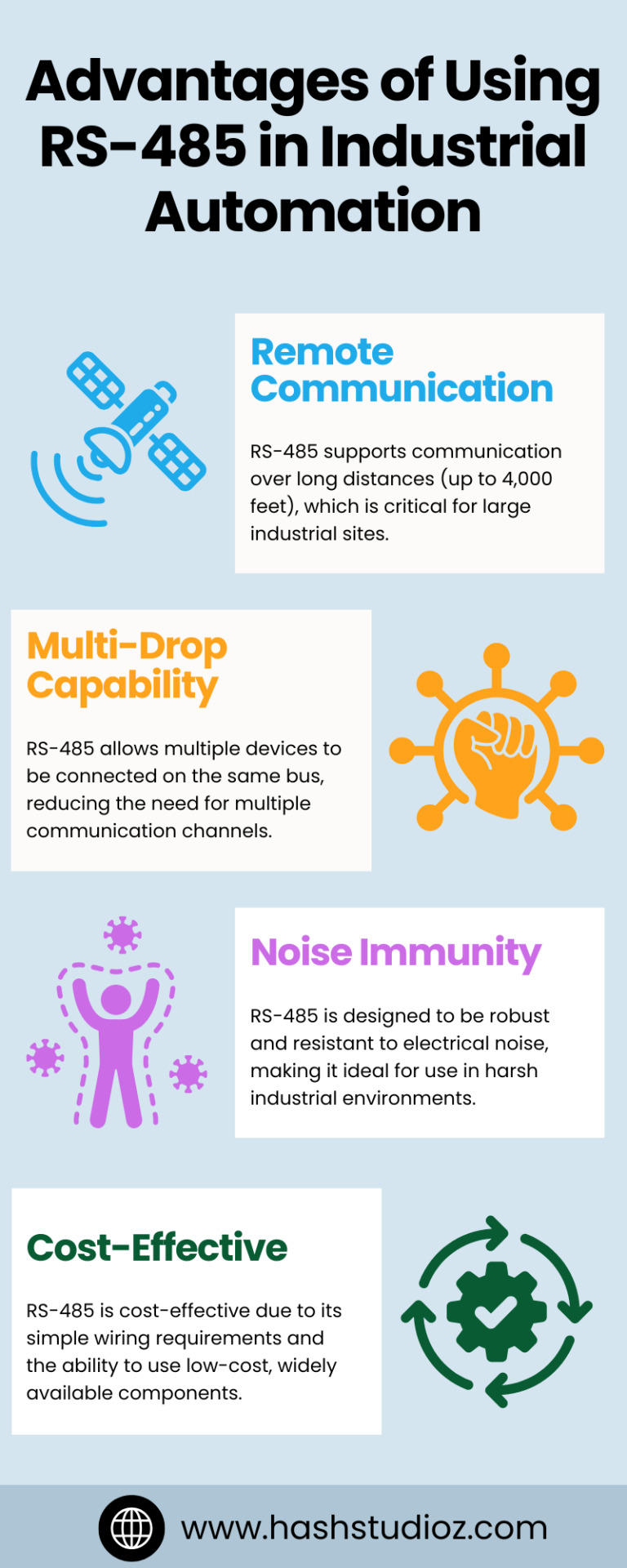
Discover the power of the 4G-LTE RS-485 Modbus Gateway with 5 Digital Inputs for seamless remote monitoring and control in industrial applications. This gateway enables efficient data communication between devices using Modbus protocol, offering reliable connectivity and real-time insights for enhanced automation, system performance, and remote troubleshooting. Ideal for IoT integrations, it ensures flexibility and scalability in managing remote assets with ease.
0 notes
Text
Vehicle Gateway: The Bridge to Intelligent Connected Vehicles
In the era of Internet of Things (IoT), Vehicle Gateway has emerged as a key technology. It acts as a bridge, enabling seamless communication between vehicles and the external world.

What is a Vehicle Gateway?
A Vehicle Gateway is a device that integrates multiple communication technologies, such as 4G/5G, Wi-Fi, and Ethernet. It allows vehicles to connect to the internet and exchange data with cloud platforms, other vehicles, and infrastructure.
Why Do We Need Vehicle Gateways?

Introducing the SV900: A Cutting-Edge Vehicle Gateway
Key Features of the SV900
Dual 5G or 5G+4G connectivity for redundancy and reliability
Optional Wi-Fi support with speeds up to 1774Mbps (Wi-Fi 6)
Multiple Ethernet ports for wired connectivity
Rugged design with IP40 protection and wide operating temperature range
Supports various VPN protocols and industrial protocols like MQTT and Modbus
Integrated with Star-Cloud platform for remote management
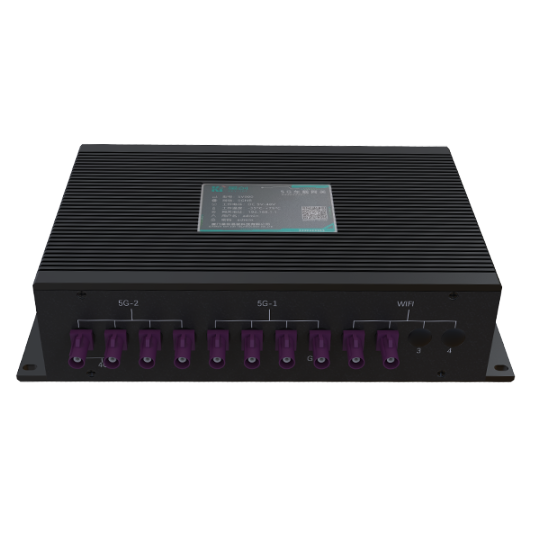
Empowering the Future of Connected Vehicles
The SV900 Vehicle Gateway enables a wide range of IoT applications in the automotive industry. From fleet management to autonomous driving, it provides the critical link between vehicles and the digital world. With its robust features and reliable performance, the SV900 is a top choice for building intelligent connected vehicle solutions.Vehicle Gateway technology is driving the evolution of smart transportation. As a leader in this field, the SV900 is well-positioned to accelerate the adoption of connected vehicles and shape the future of mobility.
1 note
·
View note
Text
Industrial Networking Solutions: Key to Digitalization is Anticipated to Witness High Growth

Industrial networking solutions enable communication and connectivity between machines, people, and systems across factories and manufacturing plants. They help optimize production processes and improve operational efficiency by eliminating downtime and unnecessary human intervention. The industrial networking solutions market comprises sensors, controllers, switches, routers, gateways, and software that allow devices and systems to connect and exchange data. The growing need for real-time data collection, analysis, and monitoring across industrial operations is fueling demand for industrial networking solutions. Communication protocols like PROFINET, EtherNet/IP, Modbus TCP, and Ethernet enable fast and secure exchange of critical production and process information in harsh industrial environments.
The Global industrial networking solution market is estimated to be valued at US$ 30.23 Bn in 2024 and is expected to exhibit a CAGR of 20.3% over the forecast period of 2024 to 2031. Factors such as rising digitalization initiatives, emergence of Industry 4.0 technologies, and increased focus on optimizing asset utilization are expected to propel market growth.
Key Takeaways
Key players operating in the industrial networking solution market are Aruba Networks, Belden Inc., Cisco Systems, Inc., Dell Technologies, Eaton Corporation plc, Huawei Technologies Co., Ltd., Juniper Networks, Nokia, Rockwell Automation, Schneider Electric, Siemens AG, Sierra Wireless, Telit, Texas Instruments, and Wind River. These players are focusing on development of innovative networking solutions with multiple connectivity options and enhanced cybersecurity features to maximize profits.
The key opportunities in the Industrial Networking Solution Market Demand industrial IoT deployments, adoption of private LTE/5G networks for critical infrastructure, and uptake of cloud-based networking software. Industrial firms are also increasingly adopting edge computing technologies that require high-performance networking infrastructure.
Globally, Asia Pacific and Europe are undergoing rapid industrialization which is driving infrastructure investments including industrial networking. Meanwhile, operators in North America and Middle East are modernizing their existing plants and implementing advanced automation. This global expansion is allowing networking players to cater to diversified requirements and scale their operations.
Market Drivers:
The growing adoption of industry 4.0 technologies across manufacturing sectors is a major market driver. Networks form the backbone of smart factories by enabling machine-to-machine communication and ubiquitous connectivity. Furthermore, initiatives like Made in China 2025 are promotingdigitization of manufacturing through industrial IoT solutions adoption which demands reliable networking infrastructure.
Market Restraints:
High initial capital investments remain the key market restraint as setting up an industrial network requires deployment of considerable networking hardware and associated software/services. Furthermore, integration of legacy systems with advanced networking platforms is technically challenging which increases complexity and costs for end users. Lack of skilled workforce also hampers smooth implementation of networking projects in some regions.
Segment Analysis
Industrial Ethernet sub segment is dominating this Industrial Networking Solution Market Analysis. Ethernet based communication protocols provide reliable network connectivity. Ethernet switches, routers, communication modules etc. allow network devices to connect seamlessly. This helps in real-time monitoring and control of industrial operations from command centers. Integration of IIoT and deployment of automated systems in industries is driving demand for industrial ethernet networking solutions.
Global Analysis
North America region dominates the industrial networking solution market currently. Presence of major players and early industrial automation adoption supports market growth. Europe follows North America in market share. Growing manufacturing industries and upgrading of existing infrastructure with latest technologies drives the European market. Asia Pacific region is expected to grow at fastest pace during the forecast period. Investment in infrastructure development and industrialization makes countries like China and India lucrative markets. Latin America and Middle East & Africa also show positive trends and expected to offer new opportunities with increasing automation.
Get more insights on Industrial Networking Solution Market
Vaagisha brings over three years of expertise as a content editor in the market research domain. Originally a creative writer, she discovered her passion for editing, combining her flair for writing with a meticulous eye for detail. Her ability to craft and refine compelling content makes her an invaluable asset in delivering polished and engaging write-ups.
(LinkedIn: https://www.linkedin.com/in/vaagisha-singh-8080b91)
#CoherentMarketInsights#IndustrialNetworkingSolutions#IndustrialNetworkingSolutionsMarket#IndustrialNetworkingSolutionsMarketOutlook#IndustrialNetworkingSolutionsMarketForecasts#Iot#Industry4.0#NetworkSecurity#WirelessSolutions#Ethernet#Automation
0 notes
Text
The industrial landscape is undergoing a metamorphosis, driven by the transformative power of the Internet of Things (IoT) and the dawn of Industry 4.0. At the heart of this revolution lies seamless communication between a myriad of machines and devices that populate the factory floor. This symphony of data exchange hinges on two crucial technologies: Remote Input/Output (I/O) modules and Industrial IoT (IIoT) Gateways. Let's delve into the intricate dance between these technologies and how they unlock the true potential of Industry 4.0.
Demystifying Remote I/O Modules
In today's era of smart work, remote I/O modules serve as extended hands for the factory's control system, enabling signal collection and control from sensors and actuators spread throughout the facility. Connected to a central controller via communication protocols like Modbus or Ethernet, these modules enable real-time monitoring and control, even for distant locations within the factory.
IIoT Gateways: The Vital Link
IIoT Gateways serve as the critical bridge between the bustling industrial world and the ever-evolving information age. IIoT Gateways are devices that serve as intermediaries between sensors, machines, and the cloud in Industrial Internet of Things (IIoT) systems. These gateways collect, process, and transmit data from connected devices to cloud-based platforms for analysis and action. IIoT Gateways play a crucial role in facilitating real-time monitoring, analysis, and control of industrial processes, leading to improved efficiency, productivity, and decision-making in manufacturing environments.
The Power of Integration
Visualise an expansive factory floor adorned with strategically placed sensors and actuators. Remote I/O modules, serving as the backbone, seamlessly collect data from these dispersed devices. The IIoT Gateway assumes the role of the central nervous system, consolidating data from multiple remote I/O modules and perfectly transmitting it to the "brain" – cloud-based analytics and control applications. This harmonious integration heralds a new era of possibilities for Industry 4.0
0 notes
Text
Empowering Industry: The Crucial Role of IoT Gateways in Industrial Connectivity
In the era of Industry 4.0, where data-driven decision-making and automation are driving innovation and efficiency, the Internet of Things (IoT) plays a pivotal role in transforming industrial operations. At the heart of this transformation lies the IoT gateway – a versatile and indispensable component of modern industrial infrastructure. In this blog post, we'll explore the significance of IoT gateways in industrial settings, their key features and benefits, and their transformative impact on industrial connectivity and intelligence.
Understanding IoT Gateways:
An IoT gateway serves as a bridge between IoT devices, sensors, and the cloud or enterprise networks, enabling seamless communication, data aggregation, and protocol translation. Essentially, it acts as a centralized hub that collects, processes, and transmits data between edge devices and backend systems, facilitating real-time monitoring, analytics, and control. In industrial environments, where diverse devices and protocols coexist, IoT gateways play a crucial role in enabling interoperability and integration, unlocking the full potential of connected ecosystems.
Key Features and Benefits:
1. Protocol Agnosticism: One of the primary functions of IoT gateways is to support multiple communication protocols, such as MQTT, Modbus, OPC-UA, and Bluetooth, allowing them to communicate with a wide range of IoT devices and sensors. This protocol agnosticism ensures compatibility and interoperability across heterogeneous networks, enabling seamless integration and data exchange.
2. Edge Computing Capabilities: With built-in processing power and storage capabilities, IoT gateways enable edge computing – the ability to perform data processing and analysis at the edge of the network, near the data source. By processing data locally and filtering out irrelevant information, IoT gateways reduce latency, bandwidth usage, and dependence on cloud services, making them ideal for latency-sensitive industrial applications.
3. Security and Data Integrity: Security is a paramount concern in industrial IoT deployments, where sensitive data and critical infrastructure are at stake. IoT gateways incorporate robust security features, including encryption, authentication, and access control, to safeguard against cyber threats and unauthorized access. By enforcing security policies and protocols, they ensure data integrity and protect industrial systems from potential vulnerabilities.
4. Scalability and Flexibility: Whether deploying in a small-scale operation or a large-scale industrial complex, IoT gateways offer scalability and flexibility to accommodate diverse requirements and evolving networks. With support for modular expansion and interoperability with third-party devices and platforms, they can easily adapt to changing needs and integrate with existing infrastructure.
5. Real-time Monitoring and Analytics: By aggregating and processing data from IoT devices and sensors in real-time, IoT gateways enable proactive monitoring, predictive analytics, and condition-based maintenance. Whether it's monitoring equipment health, optimizing energy usage, or detecting anomalies in production processes, they provide actionable insights for improved decision-making and operational efficiency.
Real-world Applications:
1. Predictive Maintenance: In manufacturing plants, industrial Iot gateway facilitate predictive maintenance by monitoring equipment performance, analyzing sensor data, and predicting potential failures before they occur. By scheduling maintenance activities based on actual usage and condition, businesses can minimize downtime, reduce costs, and prolong asset lifespan.
2. Asset Tracking and Management: In logistics and supply chain management, iot gateway enable real-time tracking and management of assets, such as vehicles, containers, and inventory. By collecting location data, monitoring environmental conditions, and optimizing route planning, businesses can improve operational efficiency, enhance customer satisfaction, and ensure compliance with regulatory requirements.
3. Environmental Monitoring: In industrial facilities, IoT gateways facilitate environmental monitoring by collecting data on air quality, temperature, humidity, and other parameters. By detecting deviations from optimal conditions and triggering alerts or automated responses, businesses can ensure workplace safety, regulatory compliance, and sustainability.
Conclusion:
As industries continue to embrace digital transformation and harness the power of IoT, IoT gateway emerge as indispensable enablers of industrial connectivity, intelligence, and innovation. With their ability to bridge the gap between edge devices and backend systems, support diverse protocols, and enable edge computing, IoT gateways empower businesses to unlock new opportunities for efficiency, productivity, and competitiveness. As we navigate the complexities of the industrial IoT landscape, IoT gateways will undoubtedly remain essential components of modern industrial infrastructure, driving progress and prosperity in the era of Industry 4.0.
0 notes
Text

IoT gateways play a crucial role in smart technology ecosystems by aggregating and processing data from various devices, ensuring seamless communication and interoperability.
#RS 485 IoT Gateway Solutions#Industrial IoT Gateway Solutions#industrial iot gateway devices#IOT gateway devices#IIoT gateway devices#MQTT IoT gateway#iot gateway manufacturers#Top IoT gateway companies#IoT gateway company#iot gateway solutions#modbus gateway#rs485 gateway#rs485 protocol#modbus rs485#modbus communication protocol#rs485 iot gateway#modbus protocol#iot gateway
0 notes
Text

Integrating ARMxy SBC with InfluxDB for Time-Series Monitoring
In the world of Industrial IoT (IIoT), the ability to efficiently monitor, store, and analyze large volumes of time-stamped data is essential. From environmental sensors in smart factories to energy meters in power systems, time-series data forms the backbone of real-time insight and historical analysis.
InfluxDB, an open-source time-series database, is designed specifically for these use cases. Combined with the industrial-grade ARMxy Edge Gateway, it creates a robust edge solution for reliable data acquisition, storage, and visualization—all without depending on cloud availability.
🧠 Why InfluxDB on ARMxy?
InfluxDB is lightweight, high-performance, and optimized for time-series workloads. It supports powerful query languages, retention policies, and integrations with monitoring tools such as Grafana. When deployed directly on an ARMxy (RK3568J/RK3568B2) gateway, it becomes a local data engine with key advantages:
Minimal latency: Store and query data at the edge
Offline reliability: Operate without cloud or internet connection
Flexible integration: Compatible with Modbus, OPC UA, MQTT, and more
🏭 Real-World Use Case Example
Imagine a factory floor with multiple PLCs controlling machinery. Each PLC sends temperature, vibration, and power consumption data every few seconds. Instead of sending that data to a remote server, it can be ingested directly into InfluxDB running on the ARMxy device.
You can then use:
Telegraf for parsing and collecting metrics
Grafana for local visualization dashboards
Node-RED to add logic and alarms
The result? A self-contained edge monitoring system capable of showing trends, detecting anomalies, and buffering data even during connectivity drops.
🔗 Integration Workflow Overview
Install InfluxDB on ARMxy via Docker or native ARM64 package
Connect data sources: Modbus devices, MQTT brokers, etc.
Configure retention policies to manage local storage
Use Grafana (also installable on ARMxy) to build dashboards
(Optional) Forward selected metrics to cloud or central server for backup
✅ Benefits of Edge Time-Series Monitoring
Faster Insights: No need to wait for data to hit the cloud
Bandwidth Optimization: Only send essential data upstream
Improved System Resilience: Data remains accessible during downtime
Security & Compliance: Sensitive data can stay on-premises
🔚 Conclusion
Deploying InfluxDB on ARMxy Edge Gateways transforms traditional data loggers into intelligent local data hubs. With flexible integration options, support for real-time applications, and a compact industrial design, ARMxy with InfluxDB is a perfect fit for smart manufacturing, energy monitoring, and any IIoT scenario that demands fast, local decision-making.
Let the data stay close—and smart.
0 notes
Text
BLIIOT Industrial Edge IoT Gateway Helps the Development of Photovoltaic Industry
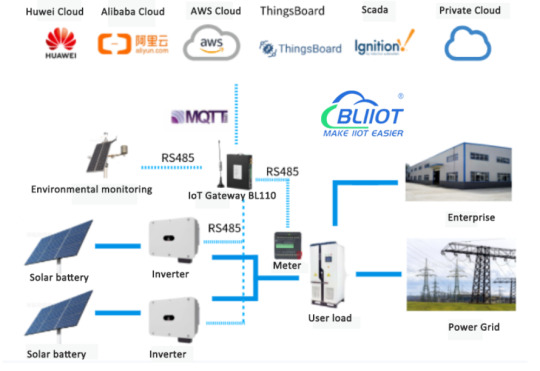
Background
Photovoltaic power generation is based on the principle of photovoltaic effect, using solar cells to directly convert sunlight energy into electrical energy. Whether it is used independently or connected to the grid for power generation, the photovoltaic power generation system mainly consists of three parts: solar panels (components), controllers and inverters. They are mainly composed of electronic components and do not involve mechanical parts. Therefore, photovoltaic power generation equipment Extremely refined, reliable, stable, long life, easy to install and maintain.
Program Overview
All photovoltaic equipment is assembled on the roof. The solar cells use the principle of photovoltaic effect produced by surface semiconductors to generate direct current. The direct current is converted into alternating current through a three-phase inverter and connected to the grid.
The photovoltaic system is mainly composed of inverters, controllers, energy meters, environmental sensors, etc. There are a large number of point signals in the system that need to be collected, such as: current, voltage, alarm, control, temperature and humidity, lighting, etc. It is characterized by a large number of signals and complex signal types, including 16bit, 32bit, and bitwise reading and writing. The cloud uses the MQTT protocol.

The project uses BL110 Edge gateway for data collection and transmission. The gateway will collect signal data from inverters, environmental sensors, and energy meters through the RS485 serial port Modbus protocol for edge computing processing, and transmit it to the photovoltaic operation and maintenance platform using MQTT.
Features
1.Stable and Reliable
BLIIOT BL110 industrial IoT gateway, industrial-grade design, has stable and reliable characteristics. The equipment has a trouble-free operation time of more than 30W hours, ensuring that data is online in real time. On the basis of the traditional photovoltaic power station, the RS485 serial port Modbus RTU communication protocol is added, which has strong versatility and strong anti-interference ability.
2.High Cost-effective
BLIIOT BL110 industrial IoT gateway has excellent performance. One gateway supports the collection of up to 50 inverters and 4,000 inverter variable attributes, greatly saving costs for users.
3.Multi-platform Concurrency
BLIIOT Technology BL110 industrial IoT gateway can upload the collected inverter data to Alibaba Cloud, Huawei Cloud, AWS, ThingsBoard and other platforms. Users can connect to public or private clouds according to their needs.
4.Security Encryption
BLIIOT BL110 industrial IoT gateway supports TSL, SSL, X.509 authentication encryption, OPEN VPN, etc. to ensure safe data transmission.
View more about BL110
0 notes
Text
Industrial IoT Gateways and PLCs: Where OT Meets IIoT
PLCs (programmable logic controllers), which serve as the brain of factory floor automation systems and offer dependable and adaptable control methods for industrial control operations, have been at the center of these systems for the past few decades. However, new Industrial Internet of Things (IIoT) technologies are offering more sophisticated functionalities and effective solutions as a result of the rapid growth of IIoT technologies.
Industrial IoT gatewayᅠis a device based on Internet of Things technology, which can connect multiple sensors, instruments, controllers and other devices to realize real-time monitoring and management of various parameters in the industrial environment. More significantly, the industrial Internet of Things gateway may link OT and IIoT, facilitate information flow, and encourage equipment collaboration, all of which support the advancement of industrial automation.
This article will explore the synergy of industrial IoT gateways and PLCs in automated production, and and how they might work together to increase production efficiency, lower costs, and improve product quality.
What is PLC?
PLC, short for Programmable Logic Controller, is a device specially used for industrial automation control. In order to satisfy the demands of industrial production, it uses computer control technology and programming to accomplish real-time control, measurement, and execution duties. PLCs are essential for controlling complex industrial applications' production processes and enhancing output quality and efficiency.
Although PLCs can take on a variety of shapes and forms, their fundamental function—to fulfill the automatic control of industrial production—remains the same. PLC is used extensively throughout a range of industries, including manufacturing, electric power, transportation, mining, etc. It has grown to be an essential component of industrial automation.
PLC and the IIoT
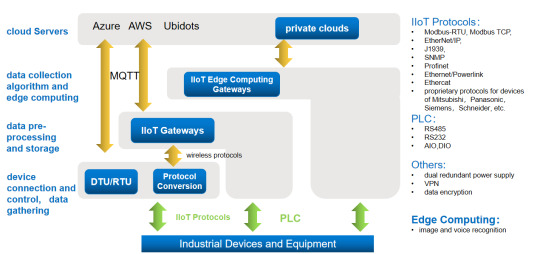
PLC is a well-known type of industrial control system, with data contact usually takes place within the local area network, and system communication typically takes place in a workshop or factory. However, a greater variety of data exchange and remote management can be accomplished by integrating the PLC control system into the Industrial Internet of Things, further advancing the industrial automation process.
For instance, real-time production line running status can be obtained through remote PLC monitoring through the Internet. This allows for the early detection and resolution of issues, increasing the effectiveness and caliber of production. Additionally, the production process can be optimized and maintained in advance through data analysis and wise decision-making, which lowers production costs and resource usage even more.
PLC and an IIoT gateway
PLCs and IoT gateways both have significant contributions to make to industrial automation, but they operate in distinct ways.
PLC
PLCs are devices with some computer-like properties that are specifically made to control industrial equipment. They are capable of doing tasks like counting, timing, arithmetic computations, and sequence control. In order to achieve accurate control of the industrial machine, it modulates the output signal using the input signal.
Industrial IoT gateway
What is an industrial gateway?ᅠAn industrial IoT gateway, on the other hand, is a kind of IoT device that connects PLCs, sensors, instruments, industrial equipment, and other intelligent hardware with features including device networking, data collecting, and edge computing. It can simultaneously transfer the gathered data to local or cloud storage programs. In order to implement device interconnection, the IoT gateway can also be utilized as a connection point between the cloud platform and PLC controllers, sensors, or other industrial equipment.
The Convergence

In order to realize PLC data on the cloud, Dusun IoT's DSGW-081 Modbus RS485 CAN Bus I/O converter (WiFi/LTE 4G/Ethernet) has rich industrial control protocols and a variety of data interfaces embedded within it. This makes it compatible with more than 95% of common PLC devices currently available (Siemens, Mitsubishi, Omron, Schneider, Delta, AB, Beckhoff, Xinjie, Inovance, Panasonic, etc.). It is an effective and dependable option that promotes the growth of industrial automation.
IoT-based Remote Monitoring and Operation Solution Via IIoT Gateways And PLCs
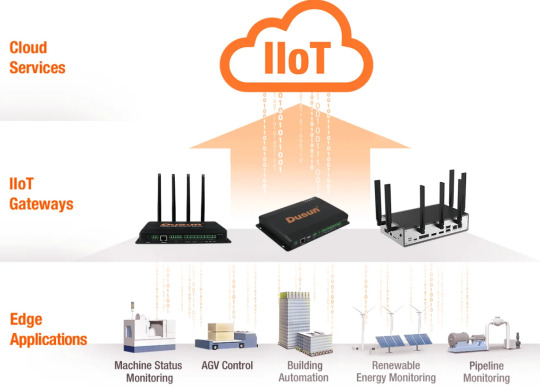
Remote monitoring solution by IIoT gateway and PLCs are mainly composed of two major components:
Industrial gateways: interface with PLC or collector, gather data from industrial equipment, enable remote monitoring and intelligent control are the two parts of the solution.
Cloud platform for IIoT applications: stores, processes, and analyzes data that smart gateways upload to various locations; it can be displayed on a big screen to realize equipment management, maintenance work order management, remote operation and maintenance, big data analysis, etc.
In general, the industrial gateway may typically connect to and collect data from PLCs downlink, and transport data to clouds uplink to enable remote equipment administration and debugging.
Final Words
The Industrial Internet of Things has grown to be a significant force in the promotion of industrial automation as a result of the ongoing development of technology. In many industries, including equipment production, sewage treatment, animal husbandry, HVAC, refrigeration, transportation, etc., professional industrial IoT solutions are employed extensively. These technologies significantly increase equipment efficiency and reliability by enabling remote monitoring and administration of industrial equipment using PLC technology.
The Industrial Internet of Things will have to deal with more difficult and tough jobs in the future. It will increasingly rely on data analysis and artificial intelligence technology as the digital age progresses in order to achieve more intelligent and adaptive operation, maintenance, and management. Additionally, to respond to changing industrial surroundings and equipment, IIoT will need more adaptable and scalable solutions as industrial equipment keeps getting upgraded.
1 note
·
View note
Text
Industrial IoT Gateway: Empowering the Future of Industry with Creative Micro Systems
The rise of the Industrial Internet of Things (IIoT) has paved the way for smart factories, connected equipment, and data-driven decision-making across various industries. As businesses seek to harness the power of real-time data, the need for effective, reliable, and secure solutions has never been more crucial. At the heart of this transformation lies the Industrial IoT Gateway, a pivotal technology that connects industrial devices to cloud systems and ensures seamless data flow. Creative Micro Systems is leading the charge in providing advanced Industrial IoT Gateway solutions that unlock the true potential of IIoT.
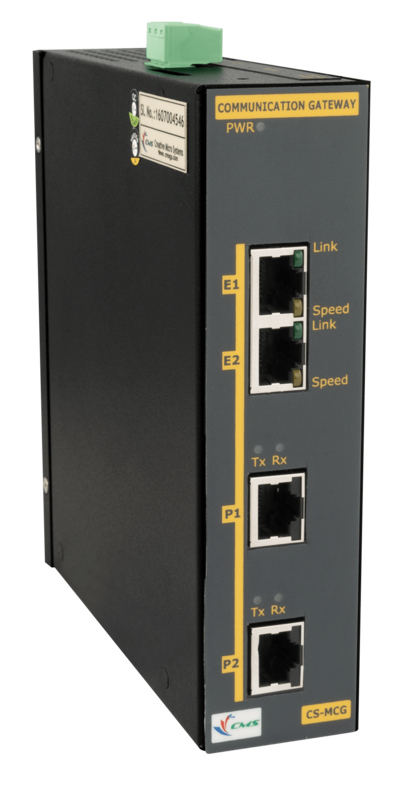
What is an Industrial IoT Gateway?
An Industrial IoT Gateway acts as an intermediary device that connects physical industrial machines and sensors to cloud platforms or enterprise systems. It gathers data from these devices, processes it locally (at the edge), and either sends relevant insights to the cloud for further analysis or makes real-time decisions on-site. Unlike traditional systems, which rely on sending all data to the cloud, IoT gateways enable localized processing, which reduces latency, conserves bandwidth, and ensures faster decision-making.
The gateway serves multiple purposes: it converts data from various industrial protocols into a standardized format, provides a secure connection for data transmission, and ensures real-time processing. This enables manufacturers and industries in sectors like energy, transportation, and agriculture to collect actionable insights from their equipment, leading to improved performance, predictive maintenance, and enhanced operational efficiency.
Creative Micro Systems: Redefining Industrial IoT Gateways
Creative Micro Systems has established itself as a leading provider of Industrial IoT Gateway solutions. The company’s focus is on creating high-performance, secure, and scalable solutions that address the unique demands of industrial environments. Their Industrial IoT Gateways are engineered to support a variety of communication protocols and are designed for rugged, real-time operation in mission-critical applications.
What sets Creative Micro Systems apart from the competition is their commitment to flexibility and reliability. Their gateways are compatible with numerous industrial protocols like Modbus, OPC-UA, MQTT, and REST, making them easily integrable into existing infrastructure. This is crucial for industries looking to modernize without disrupting their current systems.
Moreover, Creative Micro Systems ensures that its Industrial IoT Gateways are built to withstand harsh conditions commonly found in industrial settings, including extreme temperatures, humidity, and vibration. This ruggedness guarantees that the gateway continues to operate under challenging circumstances, ensuring that data collection and analysis remain uninterrupted.
Key Features of Creative Micro Systems' Industrial IoT Gateway
Real-Time Data Processing: The Industrial IoT Gateway by Creative Micro Systems processes data at the edge, reducing latency and ensuring that decision-makers have access to real-time insights. This is especially important for predictive maintenance, where timely intervention can prevent costly equipment breakdowns.
Connectivity Flexibility: Creative Micro Systems' gateways support a wide range of communication protocols, including serial, Ethernet, and wireless (Wi-Fi, LoRa, and 4G/5G). This flexibility makes it easy to integrate a diverse set of industrial devices, regardless of their communication standards.
Enhanced Security: Security is paramount in industrial environments, and Creative Micro Systems places a strong emphasis on data protection. Their gateways feature built-in encryption, secure VPN support, and firewall capabilities to safeguard sensitive data from potential cyber threats.
Scalability: Whether it's a small factory or a global network of industrial plants, Creative Micro Systems' gateways are designed to scale with business needs. Their solutions are adaptable to growing infrastructure, ensuring that companies can expand their IIoT networks without major disruptions.
Low Power Consumption: Industrial IoT devices often operate in remote or energy-sensitive environments. Creative Micro Systems ensures that their gateways are energy-efficient, reducing operational costs while maintaining continuous connectivity.
Cloud Integration: These gateways seamlessly integrate with popular cloud platforms like AWS, Microsoft Azure, and Google Cloud, enabling easy data aggregation, storage, and advanced analytics capabilities.
Why Choose Creative Micro Systems?
Creative Micro Systems stands out as a trusted partner for businesses looking to implement or upgrade their Industrial IoT Gateway solutions. Their products are not only robust and secure but also offer unmatched flexibility, scalability, and real-time data processing capabilities. By providing customized solutions that meet the specific needs of different industries, Creative Micro Systems helps companies unlock the full potential of their IIoT investments.
Benefits of Creative Micro Systems’ Industrial IoT Gateways
Operational Efficiency: Real-time monitoring and predictive analytics allow businesses to detect issues before they escalate, ensuring optimal performance and reducing downtime.
Cost Savings: By improving asset management and reducing the need for constant cloud processing, Creative Micro Systems' gateways contribute to lower operational costs.
Improved Decision-Making: With edge processing and faster access to relevant data, companies can make informed decisions faster, leading to improved overall productivity.
Seamless Integration: Whether modernizing legacy systems or integrating new IoT devices, Creative Micro Systems’ gateways offer plug-and-play compatibility with a wide variety of industrial networks.
Conclusion
In an era where industries are embracing digital transformation, Industrial IoT Gateways are essential for managing and leveraging the massive amounts of data generated by connected devices. Creative Micro Systems is at the forefront of this revolution, providing reliable, secure, and flexible solutions that enable companies to take full advantage of the IIoT. By choosing Creative Micro Systems, businesses can ensure seamless data flow, real-time decision-making, and greater operational efficiency—all critical components for success in today’s competitive industrial environment.
0 notes